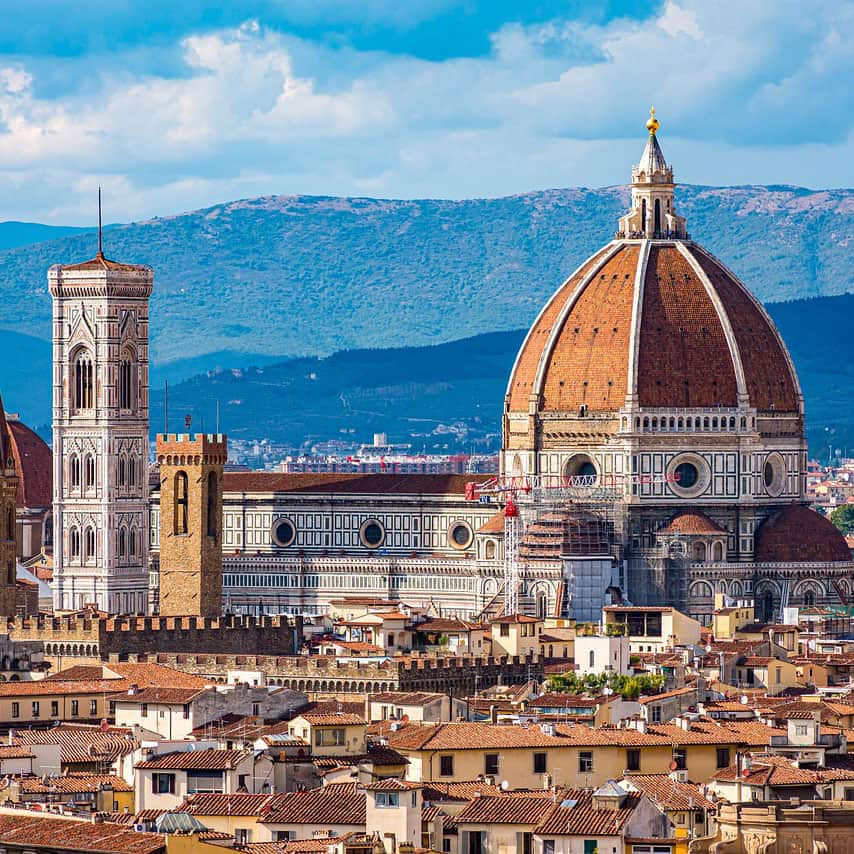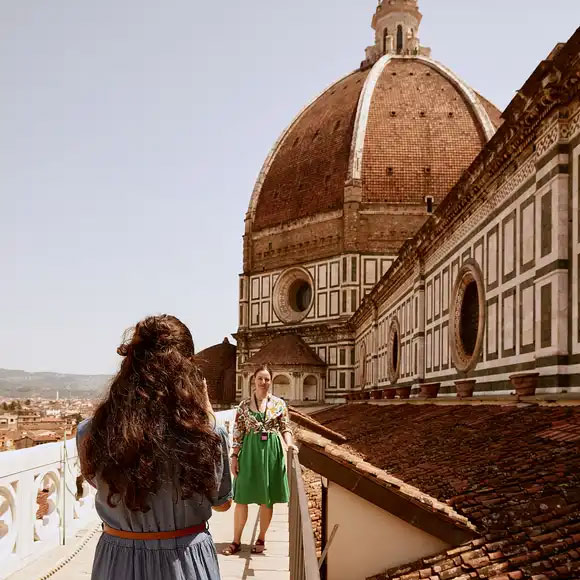Exploring Piazza del Duomo in Florence
For me, there’s no more spectacular view in Florence than turning a corner and walking into Florence’s Piazza del Duomo. You’re met with a vast expanse of white, green and pink marble, a towering bell tower, the shining Gates of Paradise on the Baptistry and the majesty of Brunelleschi’s dome. And the most magical part of all? Knowing that through this very square walked the giants of Italian history: Michelangelo arguing with Leonardo da Vinci … Lorenzo de Medici on his way to a fateful mass … popes, princes, dukes and artists marveled in the very place you now stand. These are all stories I tell on any city tour of Florence but this guide will take you through the major monuments of the Piazza del Duomo all on your own. And if you’d like to go into more detail, you can always join me for a tour!
Best of Florence City Center Tour with Accademia and Uffizi
Experience the best of Florence on this private guided tour of the city center. You’ll skip the line at the Accademia Gallery to see Michelangelo’s David before taking in the highlights of the city center from the Cathedral Square to the medieval district, Signoria Square and Ponte Vecchio.
Baptistry of San Giovanni

Let’s start where many a Florentine throughout history would have started at the very beginning of their life: the octagonal Baptistry of San Giovanni. As a Catholic in the middle ages, before even being allowed to enter the cathedral, you would be baptized here, making this a location of obvious religious and societal significance since its construction in 1059. Entering the baptistry is a must on any visit to Florence to admire the intricate mosaic tiling on the floor and the stunning glittering golden mosaic on the ceiling that dates to the mid 1200s. Take a good look at the depiction of the devil gobbling sinners in the Inferno– it’s said to have been a possible influence on the great poet Dante himself.

Florence is one place where there’s just as much to see on the outside of the monuments as inside them. Perhaps the most famous part of the baptistry are the great golden doors, said to be dubbed by Michelangelo as the Gates of Paradise. Lorenzo Ghiberti made history when he won a contest in 1401 (beating out the chagrined Filippo Brunelleschi) to cast two large bronze doors for the baptistry with scenes from the New Testament (these are now placed on the north side of the baptistry). The city of Florence loved his work so much that they commissioned him for another set of doors that were gilded with gold (located on the east side) now known as the Gates of Paradise. The doors depict scenes from the Old Testament like the creation of Adam and Eve, Noah’s Ark and David’s beheading of Goliath, all gleaming with gold. The third set of doors on the baptistry that are on the south side were the very first ones made by Andrea Pisano, depicting scenes from the life of John the Baptist. All three sets of doors are now copies and the originals can be found in the Opera del Duomo Museum located behind the Cathedral.
Cathedral of Santa Maria del Fiore (il Duomo di Firenze)

The Cathedral of Santa Maria del Fiore was begun in 1296 by Arnolfo di Cambio and is unique both for its giant size in such a relatively small town and for the fact that the Florentines covered it in marble on all sides – an endeavor that actually spans centuries. It wasn’t until 1887 that the cathedral got its now famous façade, completed by Emilio de Fabris in neo-gothic style. It stands as a testament to the Florentine faith as well as its wealth. The entry ticket doesn’t allow you to skip the line but it’s worth going inside to see the interior dome’s swirling fresco of the Last Judgment made by Giorgio Vasari in the 16th century and Paolo Uccello’s 15th century fresco of the knight Giovanni Acuto. You can also go under the geometric mosaic floor to see the crypt of architect Filippo Brunelleschi, the man responsible for one of Florence’s most famous monuments of all: the cathedral dome.

Before Filippo Brunelleschi came along, the cathedral stood open to the elements for more than a century as Florentine artists debated exactly how to construct a Dome larger than any that had ever been made before (not even the dome of the Pantheon in Rome is as wide!). It was after studying ancient architecture in Rome, that Brunelleschi was awarded the commission to complete the dome of the cathedral … but with the assistance of his hated rival Lorenzo Ghiberti! Over the course of 16 years from 1420-1436, Brunelleschi not only managed to get Ghiberti kicked off the project, he constructed what remains to this day the largest masonry dome in the world. The gigantic golden ball at the top of the dome’s lantern was created by Verrocchio and Leonardo da Vinci himself watched as machines invented by Brunelleschi hoisted it to the top in 1471. It’s well worth a climb up the sides of the dome for the view over Florence but be warned there are 463 steps to the top!

For the best view of the dome itself, climb up Giotto’s bell tower. At 414 steps, it’s still quite a climb but you can take breaks as you make your way up for a 360 degree view over all of Florence. While Giotto might be better known in art history circles for his paintings, he also began this famous bell tower in 1334. At 84.7 meters (almost 280 feet), it’s one of the most stunning bell towers in Italy.

Opera del Duomo Museum
The Opera del Duomo Museum is the hidden gem of the Piazza del Duomo and one of my favorite places to take visitors. Historically it’s the location where Michelangelo sculpted the David which was intended to be placed on the buttresses of the cathedral before it was decided to move him to the Piazza della Signoria. The area is now a museum with a modern and spacious layout that complements a vast array of unparalleled pieces. Here you can see all three original doors of the baptistry up close in all their glittering detail. The wooden models for the façade of the duomo are collected here along with a gigantic silver treasure chest, Donatello’s haunting Mary Magdalene carved in wood, and one of Michelangelo’s most moving pieces: a Pieta he sculpted toward the end of his life and which he supposedly intended to adorn his own tomb.

Right in front of Giotto’s bell tower, on the corner of Piazza del duomo and the big shopping boulevard, Via dei Calziuoli stands The Loggia del Bigallo, a curious gothic loggia that stands as a reminder of Florence’s medieval past. With its pointed-arch mullioned windows and frescoed exterior walls, you can imagine what much of Florence once looked like before its Renaissance makeover. The building was constructed to house the Compagnia della Misericordia and eventually also housed the the Compagnia del Bigallo– both charitable brotherhoods founded to help orphans and the poor. There is a small museum inside containing objects related to these organizations.
There are two curiosities on the south east corner of the Piazza del Duomo that are worth seeking out and both can be seen from the same vantage point. The first is a white disk placed in the ground with no sign or plaque to explain its purpose. It’s said to be where the great gilded copper ball on the duomo made by Verrocchio fell when it was struck by lightning in 1600. Indeed, if you stand on the disk and look up, you’ll see the replacement high above your head on the dome, glinting in the sun.
You’ll also see one of the famous projects of the cathedral that still remains incomplete even to this day: the decoration for the base of the dome’s drum. If you look up at the duomo from almost any side, you’ll see that the space between the round windows and the dome’s tiling remains unfinished stone except for this one side decorated in numerous marble arches. In 1506, this was the project awarded to Baccio d’Agnolo. But after only one side was completed the entire project ground to a halt with one choice insult by none other than Michelangelo himself. The great master, possibly jealous he didn’t win the commission, said simply, “looks like a cage for crickets.” And that was the end of Baccio d’Agnolo’s contribution to the duomo. The bare stone remaining is a reminder that the story of Florence’s cathedral is far from over.
TICKET INFORMATION
If you want to go inside any of the monuments in the Piazza del duomo (Cathedral of Santa Maria del Fiore, Brunelleschi’s Dome, Giotto’s Bell Tower, the Baptistry of San Giovanni, the Crypt of Santa Reparata and the Opera Museum.), you’ll need to pick up your tickets in advance either online (duomo.firenze.it/it/home) or at one of the three ticket offices. The entry tickets to climb the dome, enter the Baptistry, Giotto’s bell tower are not sold at the entrances to these locations.
There are three places to buy tickets in person:
- At the Opera del Duomo Museum at Piazza del Duomo, 9
- The ticket office across from the north doors of the baptistry
- The ticket office between the statues of Arnolfo di Cambio and Brunelleschi on the south side of the cathedral
Prices range from €5 to enter the baptistry to €20 to climb the dome and a number of ticket combinations are possible so you can visit all the sites over a few days. Access to the Cathedral’s terrace level is available only by guided tour. Under normal circumstances, climbing the dome is the only thing for which you’ll need to choose a specific entry time though to abide by social distancing measures, you may need to choose entry times for each of the sites. The Cathedral itself is free but again, you’ll need to pick up a ticket in advance with a specified entry time.
INSPIRATION
Guide To Florence’s Piazza Della Signoria













